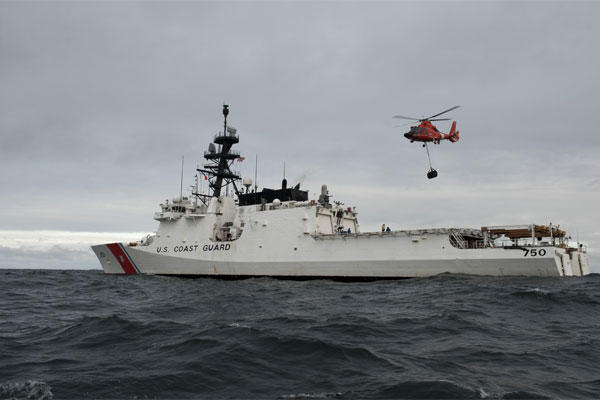JUNEAU, Alaska — The Coast Guard completed Arctic Shield 2012 October 31 after a successful summer season of sustained operations and outreach efforts in the Arctic.
Arctic Shield 2012 focused on operations, outreach and an assessment of the Coast Guard's capabilities above the Arctic Circle. The forward operating location in Barrow consisted of two Kodiak-based MH-60 Jayhawk helicopters with supporting air, ground and communications crews.
The Coast Guard deployed several surface assets to the Arctic including the Coast Guard Cutter Bertholf, which provided a persistent operational presence and command and control capability in an area where the Coast Guard lacks the permanent infrastructure of a coastal sector. Two light-ice capable 225-foot sea-going buoy tenders, a 282-foot medium endurance cutter, and a 378-foot high endurance cutter were also deployed to the region to increase offshore operational capability, ensure the safety of mariners, patrol international borders and provide additional search and rescue capabilities.
“For the first time, we had Coast Guard crews standing the watch and ready to support search and rescue, environmental protection and law enforcement operations in the Arctic," said Rear Adm. Thomas Ostebo, commander, Coast Guard 17th District. "Our Arctic Shield crews were directly responsible for saving or assisting 10 people and supporting partner agencies in conducting numerous operational missions.”
Outreach efforts kicked off in February with visits to 33 Arctic communities and 27 Arctic village schools through core missions that included: water safety, ice safety, boating safety and commercial fishing vessel safety training with local rescue organizations. Additionally, medical, dental and veterinary assistance was provided to several communities.
“Our outreach teams left a lasting, positive image of the Coast Guard that directly impacted more than 5,000 people,” said Ostebo. “Their commitment to providing basic care and safety education will open the door for future community engagement and operations throughout the Arctic region.”
Capabilities assessments included a successful joint field training exercise with U.S. Northern Command, Navy Supervisor of Salvage and Diving and other agency partners to develop experience in the deployment of different types of oil skimmers in Arctic waters. Three systems were successfully deployed, including the Coast Guard’s Spilled Oil Recovery System carried on board all Coast Guard seagoing buoy tenders, a Navy fast-sweep boom system deployed from Anchorage, and a pocket skimmer specifically designed for use in ice covered waters. The use and applicability of amphibious craft was tested in the region as well. The Coast Guard is also conducting an ongoing assessment of vessel traffic density to determine the need for additional aids to navigation and other safety improvements. Part of this effort includes working with partner agencies to conduct a Port Access Route Study for the Bering Strait. This study will lay the groundwork for implementation of appropriate ship routing measures for vessels transiting between the Bering Sea and Arctic Ocean.
“Through close partnerships with federal, state, local, and tribal agencies and frequent interaction with regulated industries, the Coast Guard is successfully preparing for operations in the Arctic through Arctic Shield,” said Ostebo. “Our goal is to use lessons learned from this year’s experience to develop a lasting plan for the safe and effective coordination of Coast Guard missions in the future.”
Logistics, personnel management, limited infrastructure, distance and weather challenges are all areas the Coast Guard will continue to address in planning for Arctic Shield 2013.
“In Alaska, we constantly adapt to the environment around us," said Ostebo. "We’re going to find the right mix of resources to protect mariners, the environment and our nation’s interests in the vast Arctic region.”






























